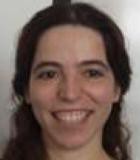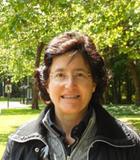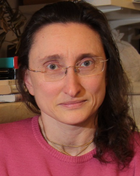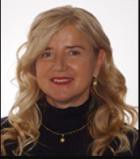Risultati: 12

Funzione/Ruolo
Professoressa Associata di Algebra all'Università di Trento. Segretaria Unione Matematica Italiana.
Percorso professionale
Alessandra Bernardi inizia il suo percorso professionale conseguendo la laurea in Matematica presso l'Università di Bologna nel 2001. Subito dopo, prosegue gli studi dottorali presso l'Università degli Studi di Milano, dove ottiene il PhD in Matematica nel 2005. Durante il dottorato, si focalizza sulle varietà che parametrizzano le forme e le loro varietà secanti, sotto la guida del Prof. A. Gimigliano.
Dopo il dottorato, intraprende un percorso di ricerca internazionale che la vede ricoprire il ruolo di Assegno di ricerca presso l'Università di Bologna fino al 2009, e successivamente come Post Doctoral Researcher presso il CIRM - Fondazione Bruno Kessler a Trento. La sua carriera prosegue all'estero come Individual Marie Curie Fellow (Post Doc) presso l'INRIA Sophia Antipolis - Méditerranée in Francia dal 2010 al 2012, dove si dedica allo studio della decomposizione di tensori strutturati.
Rientrata in Italia, assume la posizione di Ricercatrice (RTD a) presso l'Università di Torino nel 2012, per poi passare a Ricercatrice (RTD b) presso l'Università di Bologna fino al 2016. In questi anni, Alessandra sviluppa ulteriormente la sua ricerca nell'algebra multilineare e nella geometria algebrica, con particolare attenzione alle applicazioni della decomposizione di tensori e varietà secanti.
Nel 2016, Alessandra Bernardi diventa Professoressa Associata presso l'Università di Trento, dove attualmente svolge la sua attività didattica e di ricerca.
Parallelamente alla sua attività di ricercatrice e docente, coordina progetti di ricerca di rilevanza internazionale e italiana, tra cui spiccano il progetto TENORS finanziato dalla Comunità Europea (Horizon 2020) e un progetto PRIN finanziato dal MUR. È inoltre attiva in numerose società matematiche tra cui l’Unione Matematica Italiana in cui ricopre il ruolo di Segretaria, comitati scientifici e comitati editoriali di riviste internazionali (SIMAX, Open Mathematics), contribuendo significativamente al progresso della ricerca matematica a livello globale.
Alessandra Bernardi si distingue per il suo impegno nella divulgazione scientifica e nella terza missione, organizzando eventi, laboratori e conferenze per avvicinare il pubblico alla matematica. La sua ricerca si concentra principalmente sulla decomposizione dei tensori, la geometria algebrica e le loro applicazioni in diversi campi, testimoniando il suo ruolo di leader nel suo campo di studi. Ha fondato il laboratorio TensorDec a Trento che si propone come destinatario privilegiato per attività sia di ricerca che di formazione, con l'obiettivo di connettere studenti di master e laurea ai diversi aspetti del tema delle decomposizioni di tensori.
Risultati scientifici
Nel corso della sua carriera, Alessandra Bernardi ha contribuito a diversi ambiti della matematica, con risultati scientifici che spaziano dall’algebra commutativa, la geometria algebrica alla decomposizione dei tensori, influenzando sia la ricerca teorica che le applicazioni pratiche.
All'inizio della sua carriera, dopo aver conseguito il dottorato presso l'Università degli Studi di Milano nel 2005, Bernardi si è dedicata allo studio delle varietà che parametrizzano forme e le loro varietà secanti. Questo periodo ha segnato l'inizio del suo interesse per le applicazioni della geometria algebrica nella decomposizione di tensori, un campo che diventerà centrale nella sua ricerca.
Successivamente, durante il suo periodo come Marie Curie Fellow presso l'INRIA Sophia Antipolis - Méditerranée in Francia, Bernardi ha approfondito lo studio della decomposizione di tensori strutturati, esplorando questioni computazionali e teoriche. La sua ricerca in questo periodo ha contribuito a stabilire connessioni fondamentali tra l'algebra multilineare, la geometria algebrica e la teoria della complessità, affrontando problemi computazionali nella ricerca pratica delle decomposizioni tensoriali.
Le sue ricerche hanno trovato applicazioni pratiche in numerosi campi, dalla fisica quantistica, l’ecologia, alla bioinformatica, dimostrando come i tensori e le loro decomposizioni siano strumenti potenti per l'analisi e l'elaborazione dei dati. La vasta gamma di applicazioni dei suoi studi evidenzia l'importanza trasversale della decomposizione dei tensori nei problemi del mondo reale, dai sistemi di telecomunicazioni all'elaborazione delle immagini, fino alla comprensione di complessi sistemi biologici.
Attività editoriali e pubblicazioni
Dal 2017, Alessandra Bernardi ha assunto il ruolo di Editor per il SIAM Journal on Matrix Analysis and Applications (SIMAX), una rivista di primaria importanza nel campo dell'analisi matriciale e delle sue applicazioni.
Nel 2019, ha ricoperto il ruolo di Guest Editor per il volume Quantum Physics and Geometry della serie Lecture Notes of the Unione Matematica Italiana (UMILN volume 25), dimostrando il suo interesse e la sua competenza anche nei legami interdisciplinari tra matematica e fisica quantistica.
Nello stesso anno, è stata anche Guest Editor per un numero speciale di JSC (Journal of Symbolic Computation) successivo a MEGA 2019, confermando il suo impegno nell'editoria legata ai metodi effettivi in geometria algebrica e nel calcolo simbolico.
Dal 2021, Alessandra Bernardi ha ricoperto la carica di Direttore Responsabile del Notiziario UMI (Unione Matematica Italiana), svolgendo un ruolo chiave nella divulgazione scientifica e nella comunicazione all'interno della comunità matematica italiana.
A partire da febbraio 2024, ha assunto il ruolo di Editor per Open Mathematics.
L'elenco completo delle sue pubblicazioni è disponibile online, al link: https://orcid.org/0000-0002-6948-1274
Riconoscimenti e premi
Editor Top Pick tra tutti gli articoli del 2021 nel Bollettino dell'Unione Matematica Italiana per il lavoro "High order singular value decomposition for plant diversity estimation" insieme a Martina Iannacito e Duccio Rocchini.

Area STEM: Matematica
Competenze: matematica applicata, meccanica statistica
Parole chiave: applicazioni a reti neuronali, entropia, geometria delle reti, modelli di non-equilibrio, multilayer networks, networks, percolazione, reti complesse, reti molecolari della cellula, sistemi complessi, social networks
Regione: ESTERO
Funzione/Ruolo
Professoressa associata di Matematica Applicata alla Queen Mary University of London, UK e Direttrice del master in Network Science presso la stessa università
Percorso professionale
Dopo la laurea in Fisica nel 1998 all'Università La Sapienza di Roma, nel 2002 ottiene il dottorato in Fisica alla Notre Dame University, Indiana, USA. Nell'anno 2002-2003 conduce attività di ricerca presso l'Université de Fribourg in Svizzera e nel periodo dal 2003 al 2009 lavora presso l'International Institute For Theoretical Physics (ICTP) di Trieste. Nel 2009 vince un posto da assistant professor al dipartimento di Fisica della Northeastern University of Boston, USA. Nel 2013 si sposta al dipartimento di Scienze Matematiche della Queen Mary University of London dove consegue il titolo di professoressa associata nel 2015. Dal 2014 è direttrice del master in Network Science della Queen Mary University of London.
Risultati scientifici
L'attività di ricerca di Ginestra Bianconi si svolge nel campo della teoria delle reti e dei sistemi complessi e risponde alla necessità di sviluppare nuovi approcci teorici alla frontiera tra la matematica applicata e la fisica statistica. Tra i risultati più rilevanti citiamo il modello Bianconi-Barabasi che spiega l'evoluzione di network come Internet e il World Wide Web tramite un parallelo con la Bose-Einstein condensation, fenomeno quantistico delle particelle di Bose, e i lavori sull'entropia delle reti che sono rilevanti per molteplici problemi di inferenza. Le reti complesse descrivono sistemi complessi caratterizzati da una ricca struttura di interazioni e sono strutture formate esclusivamente da nodi (che rappresentano gli elementi del sistema complesso) e archi (che descrivono le interazioni esistenti tra coppie di nodi). Gli esempi di reti complesse sono molteplici e includono il cervello, e le reti biologiche della cellula, arrivando fino ai network sociali e alle infrastrutture interdipendenti. Recentemente la ricerca di Ginestra Bianconi è incentrata sui multilayer networks, che descrivono reti formate da più reti interagenti e sulla geometria dei network. In questo contesto sviluppa modelli di robustezza, evoluzione, controllo e inferenza. Ginestra Bianconi conduce inoltre attività di ricerca con collaborazioni interdisciplinari in neuroscienze, bioinformatics e reti economiche.
Attività editoriali e pubblicazioni
Ginestra Bianconi è responsabile editoriale di numerose riviste scientifiche tra cui Nature Scientific Reports e Annals of Physics. È inoltre autrice di più di 100 pubblicazioni, tra cui:
(2018) Bianconi, G, Multilayer Networks: Structure and Function (Oxford University Press)
(2014) Bianconi G, Dorogovtsev SN. Multiple percolation transitions in a configuration model of a network of networks. Physical Review E, 89(6):062814.
(2014) Menichetti G, Dall'Asta L, Bianconi G. Network controllability is determined by the density of low in-degree and out-degree nodes. Physical review letters, 113(7): 078701.
(2014) Boccaletti S, Bianconi G, Criado R, Del Genio CI, Gómez-Gardenes J, Romance M, Sendina-Nadal I, Wang Z, Zanin M. The structure and dynamics of multilayer networks. Physics Reports, 544(1):1-122.
(2013) Bianconi G. Statistical mechanics of multiplex networks: Entropy and overlap. Physical Review E, 87(6):062806.
(2010) Stehlé J, Barrat A, Ginestra Bianconi G. Dynamical and bursty interactions in social networks. Physical review E, 81(3): 035101.
(2009) Bianconi G, Pin P, Marsili M. Assessing the relevance of node features for network structure. Proceedings of the National Academy of Sciences, 106(28):11433-11438.
(2009) Kartik A, Bianconi G. Entropy measures for networks: Toward an information theory of complex topologies. Physical Review E, 80(4):045102.
(2007) Bianconi G. The entropy of randomized network ensembles. Europhysics Letters, 81(2): 28005.
(2001) Bianconi G, Barabási A-L. Competition and multiscaling in evolving networks. Europhysics Letter, 54(4):436.
(2001) Bianconi G, Ginestra, Barabási A-L. Bose-Einstein condensation in complex networks. Physical review letters, 86(24):5632.
Riconoscimenti e premi
Ginestra Bianconi fa parte della Network Science Society, della European Complex Systems Society, della London Mathematical Society e della European Women in Mathematics Society.

Area STEM: Matematica
Competenze: blockchains, geometria, geometric deep learning, informatica quantistica, pari opportunità nelle STEM, robotica
Parole chiave: analisi complessa, analisi quaternionica, dinamica olomorfa, divario di genere nella scienza, donne e matematica, donne e scienza
Regione: Emilia-Romagna
Funzione/Ruolo
Professoressa ordinaria di geometria all'Università degli Studi di Ferrara
Percorso professionale
Cinzia Bisi consegue la laurea in matematica all’Università di Modena nel 1995, trascorre l’ anno 1996 come borsista pre-doc presso l’ Indam a Roma e consegue il Dottorato di Ricerca presso l’ Università di Firenze nel 2001. Dopo alcuni anni di post-doc all’ Università di Parigi VI-VII, ricopre il ruolo di ricercatrice universitaria in Geometria all’ Università della Calabria dal 2005 al 2010, per poi trasferirsi nello stesso ruolo all’Università di Ferrara. Nel 2016 diviene professoressa associata in Geometria presso l’Università di Ferrara, per diventare professoressa ordinaria nel 2021 presso lo stesso ateneo. Parallelamente alla sua attività di ricercatrice e professoressa, nel periodo 2012-2014 entra come membro nel Senato Accademico dell’ Università di Ferrara, dal 2016 al 2021 è Delegata del Rettore dell’ Università di Ferrara per l’ Internazionalizzazione. Dal 2012 al 2014 è rappresentante del Dipartimento di Matematica ed Informatica nel Consiglio della Ricerca di Ateneo, e dal 2022 al 2026 è rappresentante del suo Dipartimento al Consiglio della Ricerca e Terza Missione di Ateneo. Dal 2024 al 2027 è membro del Nucleo di Valutazione dell’ Università della Magna Grecia. Dal 2024 al 2026 è membro GEV area CUN 1 di Anvur per la VQR 20-24, la valutazione della ricerca universitaria italiana.
Risultati scientifici
L’attività scientifica di Cinzia Bisi riguarda principalmente lo studio della dinamica olomorfa e degli automorfismi di varietà complesse, cui si aggiungono negli anni più recenti la geometria e l’analisi quaternionica ed ottonionica, che divengono poi centrali nella sua ricerca. Nell’ultimissimo periodo c’e’ stato poi un crescente interesse nelle applicazioni della geometria quaternionica al geometric deep learning, alla robotica ed al quantum computing. Cinzia Bisi si occupa anche di tematiche di genere in ambito STEM; di didattica della matematica, con particolare attenzione alle tecnologie digitali.
Attività editoriali e pubblicazioni
Ha scritto vari libri di testo di livello universitario :
(Bisi e Fioresi) Mathematical Methods for Life Sciences, Taylor and Francis, 2024
(Bisi e Fioresi) Metodi matematici per le scienze applicate, CEA-Zanichelli, 2022
(Bellisardi, Bisi e Fioresi) Esercizi risolti di metodi matematici per la scienze applicate, CEA-Zanichelli, 2024
Ha fatto curatele di svariati altri libri.
Dal 2021 è Editor degli Annali dell’ Università degli Studi di Ferrara-Sezione di Matematica, una rivista internazionale.
Dal 2019 al 2023 è stata Editor di Experimental Results, una rivista della Cambridge University Press.
È anche autrice di numerosi articoli scientifici pubblicati su riviste internazionali consultabili al sito: https://docente.unife.it/cinzia.bisi/pubblicazioni.
Riconoscimenti e premi
Nel periodo 2012-2014 è membro del Senato Accademico dell’Università di Ferrara, dal 2016 al 2021 è Delegata del Rettore dell’Università di Ferrara per l’Internazionalizzazione. Dal 2012 al 2014 è rappresentante del Dipartimento di Matematica ed Informatica nel Consiglio della Ricerca di Ateneo, e dal 2022 al 2026 è rappresentante del suo Dipartimento al Consiglio della Ricerca e Terza Missione di Ateneo. Dal 2024 al 2027 è membro del Nucleo di Valutazione dell’ Università della Magna Grecia. Dal 2024 al 2026 è membro GEV - Area 1 di Anvur per la VQR 2020-2024. Dal 2023 al 2025 è membro del Consiglio di Amministrazione del Conservatorio Frescobaldi di Ferrara.
Fa parte delle società scientifiche European Women in Mathematics e European Mathematical Society, dell’ Unione Matematica Italiana. E’ organizzatrice ed “invited speaker” di molte conferenze internazionali. Ha vinto diversi fondi europei e Pnrr. Organizza spesso eventi sull’uguaglianza di genere nelle STEM.

Area STEM: Matematica
Competenze: applicazioni economiche, finanziarie e assicurative del controllo stocastico, applicazioni economiche, finanziarie e assicurative del filtraggio stocastico, calcolo delle probabilità, matematica applicata
Parole chiave: calcolo stocastico, modelli stocastici, processi stocastici
Regione: Lazio
Funzione/Ruolo
Professoressa ordinaria di Metodi Matematici dell’Economia e delle Scienze Attuariali e Finanziarie presso la Facoltà di Economia (Dip. MEMOTEF) dell’Università di Roma La Sapienza. Componente della Commissione Scientifica dell’Unione Matematica Italiana.
Percorso professionale
Claudia Ceci ha conseguito la laurea (con lode) in Matematica nel 1990 e nel 1996 il Dottorato di Ricerca in Calcolo delle Probabilità presso l’Università di Roma la Sapienza.
Nell’anno accademico 1991-92 ha usufruito di una borsa C.N.R. per l’estero trascorrendo un periodo di ricerca presso il "Laboratoire des Probabilites" dell’Università di Parigi VI.
Dal 1993 al 1998 è stata ricercatrice universitaria presso l’Università di Firenze. Nel 1998 ha vinto il concorso nazionale per professore di seconda fascia in Probabilità e Statistica Matematica, prendendo servizio come professoressa associata presso l’Università di Chieti-Pescara. Nella stessa Università nel 2011 è diventata Professoressa ordinaria nel medesimo settore scientifico disciplinare. Dal 1 settembre 2022 è professoressa ordinaria di Metodi Matematici dell’Economia e delle Scienze Attuariali e Finanziarie presso la Facoltà di Economia dell’Università di Roma Sapienza.
Ha svolto diverse attività gestionali presso l’Università di Chieti-Pescara, tra le quali Presidente del Corso di laurea in Economia e Commercio e Coordinatrice del Dottorato di Ricerca in Scienze.
Risultati scientifici
Claudia Ceci ha ottenuto risultati di rilievo nell’ambito del filtraggio stocastico e controllo stocastico e delle loro applicazioni. La sua ricerca da diversi anni si focalizza principalmente nelle applicazioni economiche, finanziarie e assicurative; in particolare, nell’ambito di modelli di mercati finanziari incompleti anche in contesto d'informazione parziale con dinamiche di puro salto e di diffusione con salti, tra cui hedging e pricing di titoli derivati inclusi quelli creditizi e di tipo assicurativo con rischio di mortalità. Molteplici lavori riguardano problemi di scelta di portafogli finanziari e riassicurativi discussi con l’approccio classico di controllo stocastico basato sulla risoluzione dell’equazione di Hamilton-Jacobi-Bellman, o con tecniche basate sulle BSDEs (equazioni differenziali stocastiche retrograde) che sono versatili in contesto non-markoviano e infinito-dimensionale. Recentemente si è appassionata alla modellizzazione, tramite processi di contagio, di fenomeni che presentano clusters, come le perdite assicurative dovute ad eventi catastrofici.
Claudia Ceci ha partecipato ha numerosi Progetti di Ricerca, svolgendo il ruolo di responsabile di Unità per tre progetti d’interesse nazionale: COFIN 1999, PRIN 2006 e PRIN 2008. Ha diretto tre progetti GNAMPA-INdAM (Istituto Nazionale di Alta Matematica) nel 2016, 2020 e 2022.
Attualmente è responsabile di Unità del PRIN 2022 “Optimal control and games and the role of information” e dal 2024 dirige un Progetto Grande Sapienza, triennale, dal titolo “Stochastic Optimization Problems in Insurance, Finance and Economics”.
Attività editoriali e pubblicazioni
Claudia Ceci è autrice di più di 50 articoli su riviste scientifiche internazionali. Ha presentato i risultati della propria ricerca a circa 60 conferenze e workshops internazionali in Italia e all’estero. Molte delle presentazioni sono state su invito.
Fa parte dell’Editorial Board di due riviste scientifiche internazionali: Journal Stochastic Analysis and Applications e AIMS Mathematics . E’ stata Guest Editor della Special Issue Stochastic Optimization Methods in Economics, Finance and Insurance, Mathematics. Svolge il ruolo di reviewer per numerose riviste scientifiche internazionali, di tesi di dottorato e di progetti di ricerca.
Tra le principali pubblicazioni:
M.Brachetta, G.Callegaro, C.Ceci, C.Sgarra: Optimal reinsurance via BSDEs in a partially observable model with jump clusters, Finance and Stochastics, 2023.
C.Ceci, K.Colaneri, A.Cretarola: Optimal Reinsurance and Investment under Common Shock Dependence Between Financial and Actuarial Markets, Insurance: Mathematics and Economics, 2022.
M.Brachetta, C.Ceci: A Stochastic Control Approach to Public Debt Management, Mathematics and Financial Economics, 2022.
M.Brachetta, C.Ceci: A BSDE-based approach for the optimal reinsurance problem under partial information , Insurance: Mathematics and Economics, 2020.
C.Ceci, K.Colaneri, A.Cretarola: Indifference pricing of pure endowments via BSDEs under partial information , Scandinavian Actuarial Journal, published online 2020, https://doi.org/10.1080/03461238.2020.1790030.
G.Callegaro, C.Ceci, G.Ferrari: Optimal reduction of public debt under partial observation of the economic growth , Finance and Stochastics, 2020, https://doi.org/10.1007/s00780-020-00438-z.
C.Ceci, K.Colaneri, R.Frey, V.Koeck: Value adjustments and dynamic hedging of Reinsurance Counterparty Risk , SIAM Journal on Financial Mathematics, 2020.
L.Bo, C.Ceci: Locally Risk-Minimizing Hedging of Counterparty Risk for Portfolio of Credit Derivatives , Applied Mathematics and Optimization, 2020.
C.Ceci, K.Colaner, A.Cretarola: Local risk-minimization under restricted information on asset prices, Electronic Journal of Probability, 2015.
C.Ceci, A.Cretarola, F.Russo: BSDES under partial information and financial applications, Stochastic Processes and their Applications, 2014, http://dx.doi.org/10.1016/j.spa.2014.03.003.
C.Ceci, K.Colaneri: The Zakai equation of nonlinear filtering for jump-diffusion observation: existence and uniqueness, Applied Mathematics and Optimization, 2014.
C.Ceci, K.Colaneri: Nonlinear filtering for jump diffusion observations, Advances in Applied Probability, 2012.
Riconoscimenti e premi
Nel 1990 ha ricevuto il Premio di laurea in ricordo della Prof. ssa Gabriella Del Grosso, Dip. di Matematica Castelnuovo, Università di Roma Sapienza.
Ha vinto due borse C.N.R., la prima per laureandi nel 1989 (classificandosi al settimo posto su 30 borse) e la seconda per ricerca all’estero nel 1990 (classificandosi terza su 23 posti) , che ha usufruito presso il "Laboratoire des Probabilites" dell’Università Paris VI.
Dal 2020 fa parte della Giunta del Gruppo UMI-PRISMA (Probability In Statistics, Mathematics and Applications) e dal 2021 è componente della Commissione Scientifica dell’Unione Matematica Italiana (https://umi.dm.unibo.it/organi-direttivi/).

Funzione/Ruolo
Professoressa ordinaria di Matematica all'Università Tor Vergata di Roma e membro del Consiglio Direttivo dell'ANVUR
Percorso professionale
Dopo la laurea in Matematica presso l'Università La Sapienza di Roma, prosegue la sua formazione attraverso un dottorato di ricerca in matematica presso il Politecnico Federale di Zurigo (ETH) nel 1989. In seguito diventa ricercatrice confermata presso il Dipartimento di Matematica, raggruppamento Fisica Matematica dell'Università de L'Aquila fino al 1999. Da quell'anno è professoressa associata di Fisica Matematica all'Università di Roma Tor Vergata. Dal 2013 è professoressa ordinaria presso la stessa università e dal 2015 al 2018 è direttrice del Dipartimento di Matematica sempre all'Università di Tor Vergata, dal 2010 al 2020 è anche coordinatrice del Master di II livello in "Scienza e Tecnologia Spaziale". Nel 2019 viene nominata Consigliera di Amministrazione dell'Agenzia Spaziale Italiana, ruolo che mantiene fino al febbraio 2020. Da aprile 2020 è membro del Consiglio Direttivo dell'ANVUR.
Risultati scientifici
Gli interessi di ricerca di Alessandra Celletti comprendono la meccanica celeste, la teoria dei sistemi dinamici, le traiettorie interplanetarie e lo studio della dinamica dei detriti spaziali. Scienza di antichissime origini, la Meccanica Celeste studia la dinamica degli oggetti del sistema solare, dalla Luna ai pianeti, alle sonde spaziali e ai satelliti artificiali. Sono molteplici le domande a cui si cerca di rispondere: ad esempio se il futuro del sistema solare preveda collisioni tra pianeti e dove sia possibile costruire le autostrade interplanetarie. E ancora si indaga sul destino finale dei detriti spaziali o su quanto sia reale (e come sia evitabile) la minaccia che un piccolo asteroide entri in rotta di collisione con la Terra.
Attività editoriali e pubblicazioni
È autrice di diversi libri, sia a livello universitario che divulgativi:
Celletti A, Esercizi di Meccanica Razionale, Aracne editrice, 1999.
Celletti A, Stability and Chaos in Celestial Mechanics, Springer-Praxis, 2010.
Celletti A, Perozzi E, Celestial Mechanics: The Waltz of the Planets, Springer-Praxis, 2007. Celletti A, Perozzi E, Pianeti per caso, UTET, 2012.
Alessandra Celletti è anche autrice di numerosi articoli scientifici pubblicati su riviste nazionali e internazionali tra cui:
(2016) Celletti A, Gales C, Pucacco G. Bifurcation of lunisolar secular resonances for space debris orbits. SIAM, Journal on Applied Dynamical Systems, 15(3):1352-1383.
(2016) Gkolias I, Celletti A, Efthymiopoulos C, Pucacco G. The theory of secondary resonances in the spin-orbit problem. Monthly Notices of the Royal Astronomical Society, 459:1327-1339.
(2016) Lhotka C, Celletti A, Gales C. Poynting-Robertson drag and solar wind in the space debris problem. Monthly Notices of the Royal Astronomical Society, 460(1):802-815.
(2015) Celletti A, Gales C. Dynamical investigation of minor resonances for space debris. Celestial Mechanics and Dynamical Astronomy, 123(2):203-222.
(2015) Celletti A, Pucacco G, Stella D. Lissajous and Halo orbits in the restricted three-body problem. Journal of Nonlinear Science, 25(2):343-370.
(2014) Celletti A, Gales C. On the dynamics of space debris: 1:1 and 2:1 resonances. Journal of Nonlinear Science, 24(6):1231-1262.
(2014) Calleja R, Celletti A, Falcolini C, de la Llave R. An extension of Greene's criterion for conformally symplectic systems and a partial justification. SIAM Journal on Mathematical Analysis, 46(4):2350-2384.
(2013) Calleja R, Celletti A, de la Llave R. A KAM theory for conformally symplectic systems: efficient algorithms and their validation. Journal of Differential Equations, 255(5):978-1049.
(2011) Celletti A, Stefanelli L, Lega E, Froeschle' C. Global dynamics of the regularized restricted three-body problem with dissipation. Celestial Mechanics and Dynamical Astronomy, 109:265-284.
(2009) Celletti A, Chierchia L. Quasi-periodic attractors in Celestial Mechanics. Archive for Rational Mechanics and Analysis, 191(2):311-345.
Riconoscimenti e premi
Dal 2001 al 2013 presiede la Società Italiana di Meccanica Celeste e Astrodinamica (SIMCA), inoltre l'asteroide 2005 DJ1, n. 117539 porta il nome Alessandra Celletti. Nel 2010 è eletta componente a vita del Celestial Mechanics Institute, organizzazione internazionale composta da 20 esperti di Meccanica Celeste e, nel 2011, riceve dalla Comunità Europea un grant per il progetto ASTRONET-II "Marie Curie Initial Training Networks", settore Matematica. Nel 2012 è relatrice invitata al sesto convegno della European Mathematical Society e nello stesso anno ottiene dalla Comunità Europea un grant per il progetto STARDUST "Marie Curie Initial Training Networks". Nel 2015 è vice-presidente eletta della Commissione Scientifica di Meccanica Celeste dell'International Astronomical Union ed è eletta anche nella commissione scientifica dell'Unione Matematica Italiana. Nel 2016 è eletta Editor in Chief della rivista internazionale "Celestial Mechanics & Dynamical Astronomy" (edita dalla Springer), pubblicazione di riferimento nel campo della meccanica celeste e della dinamica del volo spaziale. Fa parte della società scientifica European Women in Mathematics/European Mathematical Society. Dal settembre 2018 è Presidente Commissione Scientifica di Meccanica Celeste dell'International Astronomical Union.
Nel 2023 vince il più importante premio nell'ambito della Meccanica Celeste il Brouwer Award.

Funzione/Ruolo
Professoressa aggregata in Fisica Matematica e Delegata del Rettore per le politiche di genere presso l'Università del Salento
Percorso professionale
Dopo la laurea in matematica con lode presso l’università di Bologna, Anna Maria Cherubini consegue un PhD in Matematica presso la stessa università, con una tesi sulla teoria delle perturbazioni in meccanica semiclassica. Nei due anni seguenti lavora come post-doc all’università di Padova, su problemi di teoria delle perturbazioni hamiltoniana da un punto di vista analitico e numerico. Lavora anche presso l’università di Verona, tenendo corsi di analisi matematica.
Dalla sua nomina come ricercatrice all’Università del Salento amplia i suoi interessi di ricerca ad altre aree, quali le transizioni critiche in sistemi complessi, con applicazioni all’ecologia, e ai sistemi dinamici con una componente causale. Nel 2013 è visiting researcher presso il Department of Mathematics dell’Imperial College London, dove rimane per due anni, collaborando con il gruppo di sistemi dinamici. Attualmente è professoressa aggregata presso il Dipartimento di Matematica e Fisica dell’Università del Salento, dove tiene corsi di fisica matematica. Dal novembre 2019 è Delegata del Rettore per le politiche di genere; è altresì componente della Commissione di genere della Conferenza Nazionale dei Rettori delle Università Italiane; del comitato direttivo di European Women in Mathematics (EWM), di cui coordina anche il team editoriale; del Comitato di Presidenza della Conferenza Nazionale degli Organismi di Parità Universitari e del Comitato per le Pari Opportunità dell'Unione Matematica Italiana.
Risultati scientifici
Gli interessi di ricerca di Anna Maria Cherubini comprendono vari aspetti della fisica matematica e della teoria dei sistemi dinamici. Un campo di interesse sono i sistemi hamiltoniani, sistemi con una particolare struttura geometrica, fondamentali in fisica e in particolare in dinamica classica e quantistica. In particolare ha studiato teoria della perturbazioni di sistemi hamiltoniani (in senso molto generale, si tratta di tecniche che permettono di trattare problemi aperti come ‘piccole’ variazioni di sistemi noti) sia dal punto di vista teorico che numerico (algoritmi simplettici).
Ha lavorato a problemi di transizioni critiche (o tipping points) in sistemi complessi, ovvero cambiamenti di stato repentini e irreversibili in sistemi non lineari con numerosissime variabili in interazione. Tali sistemi sono di grande interesse per il mondo reale, per esempio in ecologia, clima, finanza, dove le transizioni critiche possono avere conseguenze drammatiche. In particolare si è occupata di applicazioni all’ecologia, usando tecniche di teoria della percolazione e automi cellulari stocastici per studiare il rischio di desertificazione in territori semi-aridi, anche con lo scopo di identificare segnali precoci di transizione.
Altro campo di lavoro sono i sistemi dinamici con una componente causale: in questo ambito ha studiato fenomeni come la risonanza stocastica (un fenomeno presente in natura e usato in tecnologia nel quale il rumore ambientale amplifica un segnale invece di renderlo meno nitido).
Al momento si sta occupando di problemi che uniscono l’aspetto hamiltoniano a componenti casuali, come problemi di meccanica hamiltoniana con rumore o l’uso di tecniche di teoria ergodica in problemi di meccanica celeste.
Attività editoriali e pubblicazioni
Anna Maria Cherubini è responsabile dell’editorial team per la newsletter di European Women in Mathematics e autrice di pubblicazioni in ambito fisico-matematico nonché relative alla parità di genere nella scienza. Di seguito, una selezione scelta.
ARTICOLI
P. Cherubini, C. Reverberi, M. Mantovani and A.M. Cherubini. Dentro la teoria del prospetto: come la probabilità degli esiti cambia gli atteggiamenti verso il rischio Sistemi intelligenti, ISSN 1120-9550, (2024), in print.
C. Cerroni and A.M. Cherubini. A che punto è la notte: i numeri delle donne nella matematica italiana. Matematica, Cultura e Società 3 (2018), 5-11.
A.M. Cherubini, J.S.W. Lamb, M. Rasmussen, and Y. Sato. A random dynamical system perspective on stochastic resonance. Nonlinearity 30 (2017), 2835–2853.
F. Bagarello, A.M. Cherubini and F. Oliveri. An operatorial description of desertification. SIAM Journal on Applied Mathematics, 76.2 (2016), 433–597.
R. Corrado, A.M. Cherubini and C. Pennetta. Critical Desertification Transition in Semi-Arid Ecosystems: the role of local facilitation and colonization rate, Communications in Nonlinear Science and Numerical Simulations, 22.1 (2015), 3–12.
R. Corrado, A.M. Cherubini and C. Pennetta. Desertification transitions in semi-arid ecosystems and directed percolation, ISCS 2014: Interdisciplinary Symposium on Complex Systems, A. Sanayei, O. E. R¨ossler, I. Zelinka eds, Series: Emergence, complexity and computation, 14, Springer (2015), 99–107.
R. Corrado, A.M. Cherubini and C. Pennetta. Early warning signals of desertification transitions in semi-arid ecosystems. Physical Review E 90.6 (2014): 062705.
K. Mazzocco, A.M. Cherubini and P. Cherubini. On the short horizon of spontaneous iterative reasoning in logical puzzles and games, Organizational Behavior and Human Decision Processes 121 (2013),14–40.
A.M. Cherubini, G. Metafune and F. Paparella. On the stopping time of a bouncing ball, Discrete and Continous Dynamical Systems-B 10:1 (2008), 43–72.
P. Cherubini, E. Castelvecchio and A.M. Cherubini. Generation of hypotheses in Wason’s 2-4-6 task: an information theory approach, Quarterly Journal of Experimental Psychology 158A:2 (2005), 309–332.
G. Benettin, A.M. Cherubini and F. Fass`o. Regular and chaotic motions of the fast rotating rigid body: a numerical study, Discrete and Continous Dynamical Systems-B 2:4 (2002), 43–72.
G. Benettin, A.M. Cherubini and F. Fass`o. A ”changing chart” symplectic algorithm for rigid bodies and other dynamical systems on manifolds, SIAM Journal on Scientific Computing 23:4 (2001), 1189–1203.
LIBRI
A.M. Cherubini, P. Colella and C. Mangia eds. Empowerment e orientamento di genere nella scienza. Dalla teoria alle buone pratiche. Franco Angeli Edizioni (2011), pp.208, ISBN 9788856839623.
Riconoscimenti e premi
Anna Maria Cherubini ha coordinato il progetto STReGA per le donne nella ricerca scientifica, finanziato dal Ministero del Lavoro e delle Politiche Sociali nell'ambito del Piano di Azioni Positive (2008-2011). È stata nel core team dell'Università del Salento del progetto europeo "CALIPER: Linking research and innovation for gender equality" (SwafS-09-2018-2019-2020), oltre che nel core team di progetti per la European Researchers’ Night tra cui l’ultimo, appena approvato, ERN APULIA MED. Ha partecipato alla rete europea dottorale ITN CRITICS su transizioni critiche in sistemi complessi, e a vari progetti PRIN di interesse di ricerca nazionale.
È delegata del rettore alle politiche di genere per Unisalento.
È componente del comitato direttivo di European Women in Mathematics (EWM), di cui coordina anche il team editoriale, del Comitato Pari Opportunità dell'Unione Matematica Italiana, del Comitato di Presidenza della Conferenza Nazionale degli Organismi di Parità Universitari e della Commissione di Genere della Confererenza dei Rettori delle Università Italiane (CRUI) per la quale, tra l’altro, ha partecipato alla stesura delle linee guida per i Gender Equality Plan delle università.

Area STEM: Matematica
Competenze: analisi funzionale, geometria, matematica e musica, pari opportunità nelle STEM
Parole chiave: analisi complessa, analisi quaternionica, divario di genere nella scienza, donne e matematica, donne e scienza, donne nelle STEM, geometria e musica, sistemi dinamici, uguaglianza di genere
Regione: Marche
Funzione/Ruolo
Professoressa ordinaria di geometria all'Università Politecnica delle Marche e coordinatrice del Comitato Pari Opportunità dell’Unione Matematica Italiana
Percorso professionale
Chiara de Fabritiis consegue la laurea in matematica all’università di Pisa e il diploma del corso ordinario della Scuola Normale Superiore di Pisa nel 1989; istituzione in cui consegue il perfezionamento in Matematica nel 1994. Ricopre il ruolo di ricercatrice universitaria in Geometria alla SISSA di Trieste nel 1992-96, per poi trasferirsi nello stesso ruolo all’Università di Bologna. Nel 1999 diviene professoressa associata in Geometria presso l’Università Politecnica delle Marche, per diventare professoressa ordinaria nel 2005 presso lo stesso ateneo. Nel periodo 2008-2011 è direttrice del Dipartimento di Matematica “Vito Volterra”, dal 2022 è direttrice del Consorzio Interuniversitario per l’Alta Formazione Matematica.
Risultati scientifici
L’attività scientifica di Chiara de Fabritiis riguarda principalmente lo studio della geometria complessa delle varietà, cui si aggiungono negli anni più recenti la geometria e l’analisi quaternionica, che divengono poi centrali nella sua ricerca. Si occupa anche di tematiche di genere in ambito STEM; di didattica della matematica, con particolare attenzione all'istruzione terziaria e all'utilizzo delle tecnologie digitali, e di applicazioni della geometria alla tecnologia e all'arte, soprattutto la musica.
Attività editoriali e pubblicazioni
Ha scritto vari libri di testo sia di livello universitario sia divulgativi
C. de Fabritiis: Il teorema fondamentale dell'algebra, I teoremi de Le Scienze, 2024.
C. de Fabritiis: Il teorema di Abel-Ruffini, I teoremi de Le Scienze, 2024.
F. Alessio , C. de Fabritiis, C. Marcelli, P. Montecchiari: Matematica zero, Pearson, 2016.
M. Abate, C de Fabritiis: Geometria analitica con elementi di algebra lineare, McGraw-Hill, 2015.
È anche autrice di numerosi articoli scientifici pubblicati su riviste nazionali e internazionali tra cui:
(2023) F. Alessio, C. de Fabritiis, A. I. Telloni: A STEM Literacy Program for Students in Secondary-Tertiary Transition to Reduce the Gender Gap: a Focus on the Students’ Perception, Journal of Systemics, Cybernetics and Informatics, 19 6, 13 – 21.
(2023) A. Altavilla, C. de Fabritiis: *-Logarithm for Slice Regular Functions, Atti Accademia Nazionale Lincei, Classe di Scienze, 31(2), 491-529.
(2020) A. Altavilla, C. de Fabritiis: Equivalence of slice semi-regular functions via Sylvester operators, Linear Algebra Applications, 607C, 151-189.
(2019) A. Altavilla, C. de Fabritiis: *-exponential of Slice Regular Functions, Proceedings American Mathematical Society, 147, 1173-1188.
(2018) C. de Fabritiis, G. Gentili, G. Sarfatti: Quaternionic Hardy Spaces, Annali Scienze Scuola Normale Superiore di Pisa (5), XVIII-2 697-733.
(2006) C. de Fabritiis: Composition Operators on Bergman Spaces over the Punctured Plane, Journal Functional Analysis, 274, 152 -179.
(2002) C. de Fabritiis: Generic Subgroups of Aut(B_n), Annali Scienze Scuola Normale Superiore di Pisa (5), I, 851-868.
(1999) C. de Fabritiis: G. Gentili: On Holomorphic Maps which Commute with Hyperbolic Automorphisms, Advances in Mathematics, 144, 119 -136.
Riconoscimenti e premi
Dal 2018 fa parte della Commissione Scientifica dell’Unione Matematica Italiana, di cui coordina il Comitato Pari Opportunità. Dallo stesso anno è membro del Comitato Unico di Garanzia del suo ateneo, che presiede dal 2021. Dal 2022 è direttrice del Consorzio Interuniversitario per l’Alta Formazione Matematica. Nel periodo 2015-2023 è direttrice dell'Unità di Ricerca dell’Istituto Nazionale di Alta Matematica presso il Dipartimento di Ingegneria Industriale e Scienze Matematiche. Fa parte delle società scientifiche European Women in Mathematics e European Mathematical Society. Nel 1993 riceve il Premio di studio F. Severi.

Funzione/Ruolo
Professoressa Emerita di Analisi Numerica all'Università di Pavia
Percorso professionale
Consegue la laurea in Matematica all'Università di Pavia nel 1970, e lavora come ricercatrice presso l'Istituto di Analisi Numerica (ora IMATI-CNR) di Pavia dal 1973 al 1990. Dallo stesso anno è professoressa di Analisi Numerica presso la facoltà di Scienze dell'Università di Genova, e dal 1993 è Professoressa Ordinaria della stessa materia presso la facoltà di Ingegneria dell'Università di Pavia. Attualmente è professoressa emerita di Analisi Numerica presso il Dipartimento di Matematica dell'Università di Pavia.
Risultati scientifici
Gli interessi di ricerca di Luisa Donatella Marini riguardano i metodi numerici per equazioni alle derivate parziali (equazioni che coinvolgono le derivate parziali di una funzione incognita di più variabili indipendenti) con applicazioni alla deformazione di corpi elastici, alla simulazione di dispositivi semi-conduttori, alla meccanica dei fluidi. Un particolare interesse è stato dedicato alle tecniche di discretizzazione (per passare da un problema la cui incognita è una funzione a un problema la cui incognita è un insieme finito di numeri, risolvibile con un calcolatore) e in questo ambito ai metodi cosiddetti di Galerkin e alle loro varianti, introdotte per migliorarne le prestazioni. Tali varianti devono essere adeguate alle diverse caratteristiche di problemi che provengono da contesti applicativi diversi: la filtrazione dell'acqua attraverso strati di terra, la risposta di un dispositivo semiconduttore alla variazione del potenziale elettrico applicato, la flessione di una struttura con uno spessore sottile sottoposta ad un carico trasversale, il trasporto di un inquinante lungo un corso d'acqua etc.
Attività editoriali e pubblicazioni
Luisa Donatella Marini ha fatto parte, dal 1988 al 1993, del Comitato di Redazione della rivita SISC (SIAM Journal on Scientific and Statistical Computing), e dal 2001 è parte del Comitato di Redazione dela rivista CMAME (Computer methods in Applied Mechanics and Engineering) due delle riviste internazionali di Calcolo Scientifico più prestigiose, e dal 2008 è anche parte del Comitato di Redazione dell'Italian Journal of Pure and Applied Mathematics. Collabora inoltre al processo di selezione degli articoli da pubblicare su numerose altre importanti riviste internazionali.
È inoltre autrice di più di 100 pubblicazioni nazionali ed internazionali, tra cui:
(2016) Beirao da Veiga L, Brezzi F, Marini LD, Russo A. Virtual Element Methods for general second order elliptic problems on polygonal meshes. Mathematical Models and Methods in Applied Sciences, 26(4):729-750.
(2013) Beirao da Veiga L, Brezzi F, Cangiani A, Manzini G, Marini LD, Russo A.
Basic principles of Virtual Element Methods. Mathematical Models and Methods in Applied Sciences, 23(1):199-214.
(2013) Beirao da Veiga L, Brezzi F, Marini LD. Virtual Elements for linear elasticity problems, SIAM Journal on Numerical Analysis, 51(2):794-812.
(2009) Ayuso B, Marini LD. Discontinuous Galerkin methods for advection-diffusion-reaction problems. SIAM Journal on Numerical Analysis, 47(2):1391-1420.
(2006) Brezzi F, Cockburn B, Marini LD, Süli E. Stabilization mechanisms in discontinuous Galerkin finite element methods. Computer Methods in Applied Mechanics Engineering, 195(25-28), 3293-3310.
(2005) Arnold DN, Brezzi F, Marini LD. A Family of Discontinuous Galerkin Finite Elements for the Reissner-Mindlin plate. Journal of Scientific Computing, 22(1): 25-45.
(2002)Arnold DN, Brezzi F, Cockburn B, Marini LD, Unified analysis of Discontinuous Galerkin Methods for Elliptic Problems. SIAM Journal on Numerical Analysis, 39(5):1749-1779.
(1989) Marini LD, Quarteroni A. A relaxation procedure for domain decomposition methods using finite elements. Journal of Numerical Mathematics, 55:575-598.
(1985) Marini LD. An inexpensive method for the evaluation of the solution of the lowest order Raviart-Thomas mixed method. SIAM Journal on Numerical Analysis, 22 (3):493-496.
(1985) Brezzi F, Douglas J jr., Marini LD. Two families of mixed finite elements for second order elliptic problems. Journal of Numerical Mathematics, 47:217-235.
Riconoscimenti e premi
Luisa Donatella Marini ha co-organizzato il mini simposio "Applications of the Virtual Element Method" alla Conferenza GAMM (International Association of Applied Mathematics and Mechanics) di Lecce, 2015. Fa inoltre parte della General Assembly e del Managing Board di ECCOMAS (European Community on Computational Methods in Applied Sciences) ed è componente dell'European Academy of Science dal 2010.

Funzione/Ruolo
Group Leader al Max Planck Institute for Mathematics in the Sciences (Germania).
Percorso professionale
Dopo la laurea magistrale in Matematica all'Università di Bonn, nel 2020 ottiene il dottorato di ricerca presso il Max Planck Institute for Mathematics in the Sciences (MPI MiS). Dopo un postdoc all’Alan Turing Institute di Londra, vince una Minerva Fast Track Fellowship della Max Planck Society, e nel 2021 torna all’MPI MiS per guidare un gruppo di ricerca che studia grafi e ipergrafi. Da marzo 2023 sarà Assistant Professor in matematica applicata alla Vrije Universiteit Amsterdam.
Risultati scientifici
L'attività di ricerca di Raffaella Mulas si focalizza sulla teoria delle reti, e in particolare sulla teoria spettrale di grafi e ipergrafi. I suoi risultati sono principalmente di matematica pura, ma ha diverse collaborazioni interdisciplinari che le permettono di lavorare anche su applicazioni, ad esempio di fisica e di biologia.
Attività editoriali e pubblicazioni
[2022] Mulas R, Horak D, Jost J. Graphs, Simplicial Complexes and Hypergraphs: Spectral Theory and Topology. In: Higher-Order Systems, Understanding Complex Systems, F. Battiston and G. Petri (eds.), Springer.
[2022] Mulas R, Kuehn, C, Böhle T, Jost J. Random walks and Laplacians on hypergraphs: When do they match?. Discrete Applied Mathematics, 317:26-41.
[2022] Galuppi F, Mulas R, Venturello L. Spectral theory of weighted hypergraphs via tensors. Linear and Multilinear Algebra, DOI: 10.1080/03081087.2022.2030659.
[2021] Mulas R, Zhang D. Spectral theory of Laplace operators on oriented hypergraphs. Discrete Mathematics, 344(6):112372.
[2021] Mulas R. A Cheeger Cut for Uniform Hypergraphs. Graphs and Combinatorics, 37: 2265-2286.
[2021] Abiad A, Mulas R, Zhang D. Coloring the normalized Laplacian for oriented hypergraphs. Linear Algebra and Its Applications, 629:192-207.
[2021] Mulas R, Casey MJ. Estimating cellular redundancy in networks of genetic expression. Mathematical Biosciences, 341:108713.
[2020] Mulas R, Kuehn C, Jost J. Coupled dynamics on hypergraphs: Master stability of steady states and synchronization. Physical Review E, 101(6):062313.
[2019] Jost J, Mulas R. Hypergraph Laplace operators for chemical reaction networks. Advances in Mathematics, 351:870–896.
Riconoscimenti e premi
Nel 2020, ha vinto il Premio Donna di Scienza Giovani, dell'associazione Scienza Società Scienza. Nel 2021, ha vinto una Minerva Fast Track Fellowship della Max Planck Society, e dallo stesso anno è Membro eletto dell’Elisabeth-Schiemann-Kolleg.
Inoltre, per le sue attività di divulgazione ha vinto un premio al Science Slam del Max Planck Society PhD-net nel 2018. Con una sua illustrazione, nel 2021 ha vinto il primo premio alla Mathematics and Diversity Art Competition dell’Università di Southampton.

Funzione/Ruolo
Professoressa ordinaria di Analisi Matematica presso la Università degli Studi di Catania
Percorso professionale
Dopo la laurea in Matematica all’Università degli Studi di Catania nel 1988, diventa, nel 1989, Cultrice della Materia di Analisi Matematica presso la Facoltà di Ingegneria dell'Università di Catania. Nel 1990 supera l'esame di ammissione al Dottorato Ricerca in Matematica presso l'Università di Catania. Nel 1992 diventa ricercatrice e nel 2000 Professoressa Associata all'Università di Catania. Nel 2012 le viene conferito il PhD in Mathematics dalla Luleå University (Svezia). Nel 2013 ottiene la abilitazione scientifica nazionale a Professoressa Ordinaria di Analisi Matematica e dal 2017 è Professoressa Ordinaria di Analisi Matematica presso la Università di Catania. E’ Chief researcher del Center of Nonlinear Problems of Mathematical Physics, RUDN University, Mosca (Russia). Fa parte del Collegio dei docenti del Dottorato di Ricerca in Matematica della Università di Catania, e di commissioni internazionali di esame di Dottorato di Ricerca. Ha tenuto corsi di insegnamento per il Dottorato di Ricerca in Italia, Francia, Turchia e Svezia.
E’ responsabile di progetti di ricerca del "Gruppo Nazionale per la Analisi Matematica, la Probabilità e le loro Applicazioni (GNAMPA) - Istituto Nazionale di Alta Matematica", di accordi ERASMUS tra la Università di Catania ed Università straniere in Svezia, Norvegia, Turchia e Francia.
E’ Vice Preside della Facoltà di Scienze Matematiche, Fisiche e Naturali della Università di Catania dal 2009 al 2012, viene eletta, nel 2012, Presidente del Corso di Laurea Magistrale in Scienze per la Tutela dell'Ambiente della Università di Catania, e nel 2013 Direttrice del “Centro Universitario per la Tutela e la Gestione degli Ambienti Naturali e degli Agro-Ecosistemi” (C.U.T.G.A.N.A.).
E’ delegata del Rettore della Università di Catania alla Internazionalizzazione in ambito scientifico.
Referente per Catania della Unione Matematica Italiana, membro della Accademia Gioenia, membro proponente del "Centro di Matematica per la Tecnologia Angelo Marcello Anile" della Università di Catania, membro proponente del "Centro interdipartimentale di ricerca per il community engagement” (CUrE) della Università di Catania. E’ inserita nell’Albo degli esperti valutatori della Agenzia Nazionale della Valutazione della Università e della Ricerca (A.N.V.U.R.).
Risultati scientifici
È attualmente responsabile di un gruppo di ricerca che si interessa dello studio di equazioni alle derivate parziali, lineari e quasi-lineari, e di cambiamenti climatici e loro impatto. Con il suo team ha definito un indice che permette di calcolare con facilità l'effetto territoriale della sensibilità alla desertificazione al fine di superare il limite di protocollo internazionale “MEditerranean Desertification And Land Use European” (MEDALUS), che non prevede una stima della sensibilità alla desertificazione di una zona territoriale (comunale, provinciale, regionale, zona idrografica) attraverso un valore unico. Tale indice ha vantaggi significativi, perché produce efficaci classifiche, con la conseguente possibilità di elaborare i dati comparativi in relazione a diversi periodi di tempo.
Nell’ambito di tale ricerca di matematica applicata alla tutela all’ambiente si studiano, inoltre, gli effetti dell'impatto, sul clima e sull' ambiente, del trasporto di polvere sahariana sul particolato (PM10).
I risultati di tali ricerche sono stati esposti in convegni internazionali in tutti e 5 i continenti, di cui circa 20 da lei organizzati in Europa e USA, facendo parte di comitati scientifici in cui talvolta è stata l'unico membro italiano. Ha tenuto seminari in numerose Università italiane ed estere, essendo, solo a titolo di esempio: ospite di gruppi di ricerca, ospite su invito in occasione di semestri intensivi dell’Istituto Nazionale di Alta Matematica (I.N.D.A.M.), ospite del “Centro di Ricerca Matematica E. De Giorgi” della "Scuola Normale Superiore" di Pisa, del "Newton Institute" di Cambridge, del Department of Mathematics della “Research Melbourne Institute of Technology” di Melbourne, della “Tokyo University of Science” di Tokyo, del “Florida Institute of Technology” di Miami, del Department of Mathematics, della“Harvard University” di Boston, del "Mittag-Leffler" Institute della Accademia reale svedese delle Scienze di Stoccolma.
Attività editoriali e pubblicazioni
È Editor in Chief unico della rivista internazionale "Journal of Mathematics Research", pubblicata dal Canadian Center of Science and Education, Editor del volume "Journal of Inequalities and Applications", ed. Springer. 2015, membro di Editorial Board di numerose riviste internazionali pubblicate su Scopus e Web of Science con impact factor.
È autrice di oltre 90 pubblicazioni scientifiche, a nome singolo e in collaborazione con circa 30 coautori, di cui un terzo italiani e gli altri europei ed extraeuropei. Ad un solo nome sono pubblicate note scientifiche su riviste che figurano tra le prime 10 del Journal Citation Reports e pubblicazioni che, in entrambi i database Scopus e Web of Science, hanno più di 150 citazioni.
Solo a titolo di esempio, alcune tra le sue pubblicazioni scientifiche:
(2021) Hamdy M. Ahmed, Reda A. Elbarkouky, Othman A. M. Omar, and Maria Alessandra Ragusa. Models for COVID-19 Daily Confirmed Cases in Different Countries. Mathematics, 9:659.
(2018) Guliyev V, Omarova M, Ragusa MA, Scapellato A. Commutators and Generalized Local Morrey Spaces. Journal of Mathematical Analysis and Applications, 457 (2): 1388-1402.
(2017) Cuspilici A, Monforte P, Ragusa MA. Study of Saharan dust influence on PM10 measures in Sicily from 2013 to 2015. Ecological Indicatiors, 76: 297-303.
(2017) Deringoz F, Guliyev V, Ragusa MA. Intrinsic Square Functions on Vanishing Generalized Orlicz-Morrey Spaces. Set-Valued and Variational Analysis, 25: 807–828.
(2017) Ragusa MA, Scapellato A. Mixed Morrey spaces and their applications to partial differential equations. Nonlinear Analysis-Theory Methods & Applications, 151: 51-65.
(2017) Duro A, Piccione V, Ragusa MA, Rapicavoli V, Veneziano V. Enviromentally Sensitive Patch Index of desertification risk applied to the main habitats of Sicily. Book Series: American Institute of Physics, 1863, Article Number: UNSP 510005.
(2014) Benboenou S, Ragusa MA, Terberche M. Remarks on Leray's self-similar solutions to the 3D magnetohydrodynamic equations. Mathematical Methods in the Applied Sciences, 37 (17): 2615-2618.
(2013) Ragusa MA, Tachikawa A, Takabayashi H. Partial regularity of p(x)-harmonic maps. Transactions of the American Mathematical Society, 365 (6):3329-3353.
(2012) Persson LE, Ragusa MA, Samko N, Wall P. Commutators of Hardy operators in vanishing Morrey spaces. Book Series: American Institute of Physics, 1863:859-866.
(2008) ) Polidoro S, Ragusa MA. Harnack inequality for hypoelliptic ultraparabolic equations with a singular lower order term. Revista Matematica Iberoamericana Vol. 24, 1011-1046.
(2002) Ragusa MA. Local holder regularity for solutions of elliptic system. Duke Mathematical Journal, 113 (2):385-397.
(2000) D. Palagachev, M.A. Ragusa, L. Softova. Regular Oblique derivatives problem in Morrey Spaces. El. Journal of Differential Equations (39).

Funzione/Ruolo
Professoressa ordinaria di Ricerca operativa e Presidente della International Federation of Operational Research Societies, Università di Brescia
Percorso professionale
Dopo la laurea in Matematica nel 1980 presso l'Università degli Studi di Milano, prosegue la sua formazione frequentando la Scuola di Perfezionamento in Matematica. Nel 1983 consegue il diploma, diventando ricercatrice operativa. Dal 1983 al 1987 è professoressa associata della facoltà di Scienze Matematiche, Fisiche e Naturali dell'Università di Udine. Diviene poi titolare di un incarico di collaborazione all'Istituto per le Applicazioni della Matematica e dell'Informatica del CNR, dal 1986 al 1987. Dal 1994 è professoressa ordinaria di Ricerca Operativa della facoltà di Economia dell'Università di Brescia. Dal 2002 al 2008 è Preside della stessa facoltà. Dal 1 novembre 2016 è Prorettrice Vicaria dell'Università di Brescia.
Risultati scientifici
L'attività di ricerca di Maria Grazia Speranza è orientata allo studio di modelli di programmazione matematica a variabili miste intere, cioè di modelli di ottimizzazione in cui si vuole minimizzare o massimizzare una funzione le cui variabili sono vincolate a un insieme prefissato e devono in parte assumere valori interi. Tali modelli sono stati applicati a diversi problemi reali, in particolare nell'area della finanza, dove la decisione da prendere riguarda come investire un capitale in titoli con l'obiettivo di minimizzare il rischio dell'investimento garantendo un dato rendimento medio, e nell'area del trasporto e della logistica, dove la decisione riguarda ad esempio scelte di localizzazione o di distribuzione con l'obiettivo di minimizzare i costi garantendo un dato livello di servizio. Le ricerche più recenti riguardano il valore della collaborazione e la mobilità sostenibile.
Attività editoriali e pubblicazioni
Maria Grazia Speranza è responsabile editoriale di numerose riviste scientifiche come Transportation Science e EURO Journal on Transportation and Logsistic. È inoltre autrice di oltre 150 pubblicazioni, tra cui:
((2018) Archetti C, Christiansen, M, Speranza MG. Inventory routing with pickups and deliveries, European Journal of Operational Research, 268:314–324.
(2018) Speranza MG. Trends in transportation and logistics, European Journal of Operational Research, 264: 830–836.
(2017) Guastaroba G, Savelsbergh M, Speranza MG. Adaptive kernel search: A heuristic for solving mixed integer linear programs, European Journal of Operational Research, 263: 789-804.
(2017) Archetti C, Boland N, Speranza MG. A matheuristic for the multi-vehicle inventory routing problem, Informs Journal on Computing, 29:377-387.
(2016) Guastaroba G, Vigo D, Speranza MG. Intermediate facilities in freight transportation planning: a survey, Transportation Science, 50:763-789.
È inoltre coautrice dei volumi:
S. Martello, M.G. Speranza, Ricerca operativa per l'economia e l'impresa, Esculapio, 2012.
R. Mansini, W. Ogryczak, M. G. Speranza, Linear and Mixed Integer Programming for Portfolio Optimization, EURO Advanced Tutorials on Operational Research, Springer, 2015.
Riconoscimenti e premi
Nel 2008-2009 è stata Vice-Presidente di IFORS (International Federation of Operation Research Societies). Nel 2011-2012 è stata Presidente dell'EURO (Association of European Operational Research Societies). Nel 2014 è stata Presidente della Transportation Science and Logistic Society di INFORMS (The Institute for Operations Research and the Management Science). E' membro dei comitati scientifici dei principali convegni internazionali nell'area dei trasporti e della logistica. E' chair del program committee del convegno IFORS che si terrà a Quebec City nel 2017. E' stata plenary speaker a numerosi convegni internazionali e in particolare a Optimization days 2005 a Montréal (insieme a John Nash) e alla 27th European Conference on Operational Research tenutasi a Glasgow nel 2015.

Area STEM: Matematica
Competenze: analisi causale, con successive applicazioni in campo medico, finanziario e economico, modelli grafici markoviani, statistica, sviluppo di strumenti statistici per dati multivariati
Parole chiave: credit scoring, modelli per dati individuali in ambito biomedico e epidemiologico, modelli per la previsione di insolvenza delle piccole e medie imprese (PMI), responsabilità sociale di impresa
Regione: Umbria
Funzione/Ruolo
Professoressa ordinaria di Statistica all’Università degli Studi di Perugia.
Percorso professionale
Si laurea nel 1991 in Economia e Commercio presso l’Università degli Studi di Firenze, dove nel 1995 consegue il dottorato in Statistica Applicata. Dopo un’esperienza come Research Fellow presso la Open University di Milton Keynes (U.K.), vince nel 1996 il posto di Ricercatrice in Statistica all’Università degli Studi di Perugia, dove nel 2005 diventa Professoressa ordinaria.
Nel 2005 è consulente dell’Istituto Regionale per la Programmazione Economica della Toscana (IRPET) per una ricerca sull’analisi e previsione dei flussi turistici regionali.
Nel 2007 è Visiting Professor presso il Center of Research in Statistical Methodology della Università di Warwick (UK).
Nel 2007 consulente della Banca Mondiale per una indagine sulla percezione e comportamento degli abitanti di Teheran relativamente alle problematiche ambientali.
Nel 2008 consulente dell’IRPET per l’analisi della competitività delle Regioni europee.
Nel 2009 consulente del Ministero del Tesoro (Dipartimento UVAL) per per lo sviluppo di una metodologia per la definizione di aree urbane e rurali basata su variabili socioeconomiche.
Dal 2010 al 2012 fa parte del gruppo di ricerca europeo sugli aspetti economici e finanziari degli Investimenti Socialmente Responsabili, finanziato dalla fondazione svedese MISTRA.
Dal 2011 al 2013 partecipa al gruppo di ricerca “Identification of Graphical Markov Models with latent variables”, con incontri annuali presso l’ American Institute of Mathematics, Palo Alto.
Dal 2011 al 2014 fa parte del gruppo di ricerca svedese SIMSAM per lo studio degli effetti sulla salute della esposizione a fattori di rischio nell’infanzia.
Dal 2013 al 2016 è coordinatrice del Dottorato in Metodi matematici e statistici per l’economia e le scienze sociali.
Dal 2014 al 2019 è Delegata del Rettore per le Relazioni Internazionali dell’Università di Perugia, curando i rapporti con Atenei stranieri, con Ministeri italiani e con il CUN – Consiglio Universitario Italiano. Numerose le missioni all’estero.
Dal 2015 al 2019 è stata Affiliated Professor della Università di Umeå (SE).
Nel 2020, componente dell’Advisory Committee dell’ISTAT per il disegno e la implementazione della indagine nazionale sulla sieroprevalenza del COVID-19; attualmente coinvolta in due progetti di analisi di dati di pazienti affetti da COVID-19, in Toscana e in Lombardia.
Nel 2020 e nel 2021 è più volte ospite del programma SKY “I numeri della pandemia”. Dal 2020 fa parte del Rotary E-Club “Due Mondi” che si caratterizza per la organizzazione di incontri principalmemte online.
Attualmente insegna “Statistica” e “Metodi statistici per il Credit Scoring” e “Graphical Markov Models”.
Risultati scientifici
I principali risultati riguardano: (a) l’estensione dei modelli grafici markoviani a variabili con distribuzione normale asimmetrica; (b) lo studio della identificabilità puntuale o per intervallo di modelli statistici quando le informazioni sono parziali; (c) metodi parametrici di inferenza causale.
In relazione al punto (a) ha contribuito a formulare la prima estensione dei modelli grafici a variabili continue con distribuzione normale asimmetrica estesa (Extended Skew-Normal distribution). In relazione al punto (b) ha derivato le condizioni di identificabilità dei modelli grafici (gaussiani o per dati categoriali) con fattori di confondimento e dei modelli a risposta binaria o continua in presenza di fattori di selezione non ignorabili (informative missingness). In relazione al punto (c) ha inoltre derivato la scomposizione parametrica degli effetti causali in presenza di variabili intermedie binarie (causal inference with binary mediators).
I risultati sopra elencati sono stati frutto di collaborazioni scientifiche con ricercatori italiani e stranieri. Le applicazioni riguardano, in ambito microeconomico, l’analisi di dati per la previsione dell’insolvenza delle PMI, lo studio della relazione fra solvibilità e responsabilità sociale. In ambito medico e epidemiologico si è occupata della valutazione della efficacia di trattamenti medici in studi caso-controllo, e della stima della numerosità incognita di una popolazione elusiva mediante metodi cattura-ricattura.
Attività editoriali e pubblicazioni
Dal 2011 è nell’Editorial Board della rivista internazionale “Statistical Papers”.
Ha pubblicato numerosi contributi scientifici, fra cui i seguenti.
[2021] Raggi M., Stanghellini E., Doretti M. Path Analysis for Binary Random Variables. Sociological Methods and Research. Forthcoming.
[2019] Stanghellini E., Doretti M.. On marginal and conditional parameters in logistic regression models. Biometrika, 106(3):732-739.
[2018] Doretti M., Geneletti S., Stanghellini E. Missing Data: A Unified Taxonomy Guided by Conditional Independence. International Statistical Review, 86: 189-204.
[2014] Genbäck, M., Stanghellini E., De Luna X. Uncertainty Intervals for regression parameters with non-ignorable missingness in the outcome. Statistical Papers, 56(3): 829-847.
[2014] Nicolosi M., Grassi S., Stanghellini E. Item Response Models to Measure Corporate Social Responsibility. Applied Financial Economics, 24(22):1449-1464.
[2013] Stanghellini E., Vantaggi B. On the identification of discrete concentration graph models with one hidden binary variable. Bernoulli, 19(5A): 1920-1937.
[2011]. Hutton J.L., Stanghellini E. Modelling bounded health scores with censored skew-normal distributions. Statistics in Medicine, 30: 368–376.
[2009] Stanghellini E. Introduzione ai metodi statistici per il Credit Scoring. Springer Verlag Italia. Monografia.
[2005] Stanghellini E., Wermuth N. On the identification of path analysis models with one hidden variable. Biometrika, 92(2):337-350.
[2004] Stanghellini E., Van der Heijden P.G.M. A multiple-record systems estimation method that takes observed and unobserved heterogeneity into account. Biometrics, 60: 510-516.
[2003] Capitanio A., Azzalini A., Stanghellini E. Graphical Models for skew-normal variates. Scandinavian Journal of Statistics, 30: 129-144.
[1997] Stanghellini E. Identification of a single-factor model using graphical Gaussian rules. Biometrika 84: 241-244.
Riconoscimenti e premi
1997: Vincitrice ex-aequo del Premio per la migliore Tesi di Dottorato in Statistica (VII ciclo) della Società Italiana di Statistica.
1999: Assegnataria della Jemolo Fellowship presso il Nuffield College della Università di Oxford.
Dal 2010 è Elected Member dell’ International Statistical Institute.
2011: Vincitrice dello Square Grant dell’ American Institute of Mathematics.



